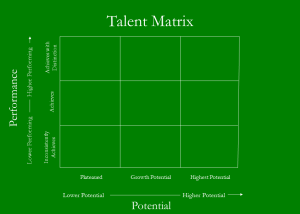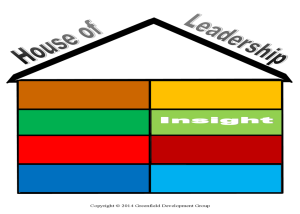Part 1 - Introduction: A House with 9 Rooms and a Grid with 9 Boxes
Leadership Training Programs: Begin with the 9 Grid Matrix
This nine-part series introduces the 9 Grid Matrix as a base tool for designing comprehensive leadership training programs, and ultimately developing leadership talent. Ten people, with varying degrees of performance and potential, are examined both in terms of their past and their future. Along the way five paths for talent development and three management tools for building bench strength are reviewed.
Part 1 - Introduction: A House with 9 Rooms and a Grid with 9 Boxes
Part 2 - Three Mid-Range Achievers: Tony, Grace and Susan
Part 3 - Two Near-the-Apex Candidates: Lucy and Keven
Part 4 - Five Paths for Talent Development – Perhaps Leadership Training Programs Aren't Everything
Part 5 - A Rising Star with a Fatal Flaw: Eddie
Part 6 - Three Tools from the House of Leadership
Part 7 - The End of An Error: Tom
Part 8 - A and B Level Performers: Diane and Larry
Part 9 - Business Results Minus People Skills Equals Deep Dysfunction: Pat
Tools and Models for Considering Leadership Training Programs
In order to understand how to develop team leaders – or leaders at more strategic levels – we are better served by contemplating the challenge of developing talent from a broader perspective. Well before the first modules of leadership training programs are outlined it is critical to determine both the terrain and possible paths for arriving at the destination. As we will observe in part four, leadership training programs are only one path for developing talent.
In our boot camps, workshops and seminars I often refer to a model for developing talent called the House of Leadership. It has nine rooms: characteristics, skills, tools, models, knowledge, insight, values, practices and talent. Refer to the nearby graphic.

Tools and Models for Leadership Talent Development
As strategic leaders we can use the House of Leadership as a model for developing talent. Depending upon both the individual being coached or mentored as well as the current situation we simply step into one of the nine rooms to focus on bringing about change. For some, a characteristic like tardiness may need to be addressed. For another person a skill like keyboarding may need to be improved. It is helpful to bring focus to our developmental endeavors by deliberately understanding which room is the focus. In short, it reminds us that there are more ways than using leadership training programs to develop people (e.g. consider coaching, mentoring, etc.)
The rooms for models and tools often have some overlap. This is the case with the 9 Grid Matrix. If we just use it to facilitate discussion about developing talent in a seminar then we are using it as a model. But in a workshop, boot camp or retreat when we have leaders use post-it notes to represent individual performers in conjunction with the 9 Grid Matrix then it serves as a tool.
The leaders are asked to place those post-it notes on the matrix to visually determine in which grid each performer falls. From here, action plans and/or recommendations can be created for developing talent. This is much better than trying to provide one-size-fits-all interventions for a team or group.
Don’t get me wrong, I’m not by any means against leadership training programs – in fact, I’ve created plenty of curricula for them and facilitated numerous sessions of them. On another day or in another post I may very well offer insight on how to best organize your particular leadership training programs. It is just that when I consider the bigger picture, I’ve learned to caution leaders about this one-size-fits-all mentality.
In this nine-part series about the 9 Grid Matrix we will use the matrix as a tool rather than a model. We’ll review ten performers and determine where they fit on the matrix. Then, we’ll recommend action for developing nine of the ten people. You’ll get a chance to recommend action for the tenth person via one of our “stump-the-chump” quizzes.
Are they real people? Yes, but names, titles and other identifying circumstances have been changed to protect confidentiality. Some of them we’ve met in leadership training programs that we’ve led and others we’ve met one-on-one in other circumstances.
Use Both Potential and Performance for Talent Development
 As you can see from the nearby graphic, the 9 Grid Matrix is developed from a traditional X and Y axis. Along one axis, we focus on potential ranging from low potential to high potential: plateaued, growth potential and highest potential. Along the other axis we focus on performance ranging from lower performing to higher performing: inconsistently achieves, achieves and achieves with distinction.
As you can see from the nearby graphic, the 9 Grid Matrix is developed from a traditional X and Y axis. Along one axis, we focus on potential ranging from low potential to high potential: plateaued, growth potential and highest potential. Along the other axis we focus on performance ranging from lower performing to higher performing: inconsistently achieves, achieves and achieves with distinction.
As a quick example, consider a very experienced sales representative that consistently ranks as either number one or two on a sales team of 30 people. In this person’s past he had been promoted to team leader in a different organization. Unfortunately that organization had little maturity when it came to executing leadership training programs.
He was not provided with sufficient training, internal mentoring or external coaching to transition from being a good performer to being a leader of sales people. This experience left a bad taste in his mouth. He decided that it was more rewarding, and less stressful, to continue as a top-performing sales person. We’d rank this person as “achieves with distinction” along the performance axis but “plateaued” along the potential axis.
Insight for Talent Development
 Now for just a moment, step into the room called Insight from the House of Leadership. I want to challenge you to review and reflect upon the following five questions as you continue reading the upcoming parts of this nine-part series about the 9 Grid Matrix.
Now for just a moment, step into the room called Insight from the House of Leadership. I want to challenge you to review and reflect upon the following five questions as you continue reading the upcoming parts of this nine-part series about the 9 Grid Matrix.
- Can you spot which people are prime candidates for further leadership development?
- Can you use the 9 Grid Matrix with these ten people for decision making purposes?
- Can you identify the strategies appropriate for developing their talent?
- Can you identify alternative strategies for taking action if someone does not have potential?
- Can you see parallels with this virtual team of ten and the members of your organization?
So there you have it – a house with nine rooms and a matrix with nine boxes. One model and one tool for a successful launch before you even plot any curricula in leadership training programs.
Up next, Part 2 – Three Mid-Range Achievers: Tony, Grace and Susan
